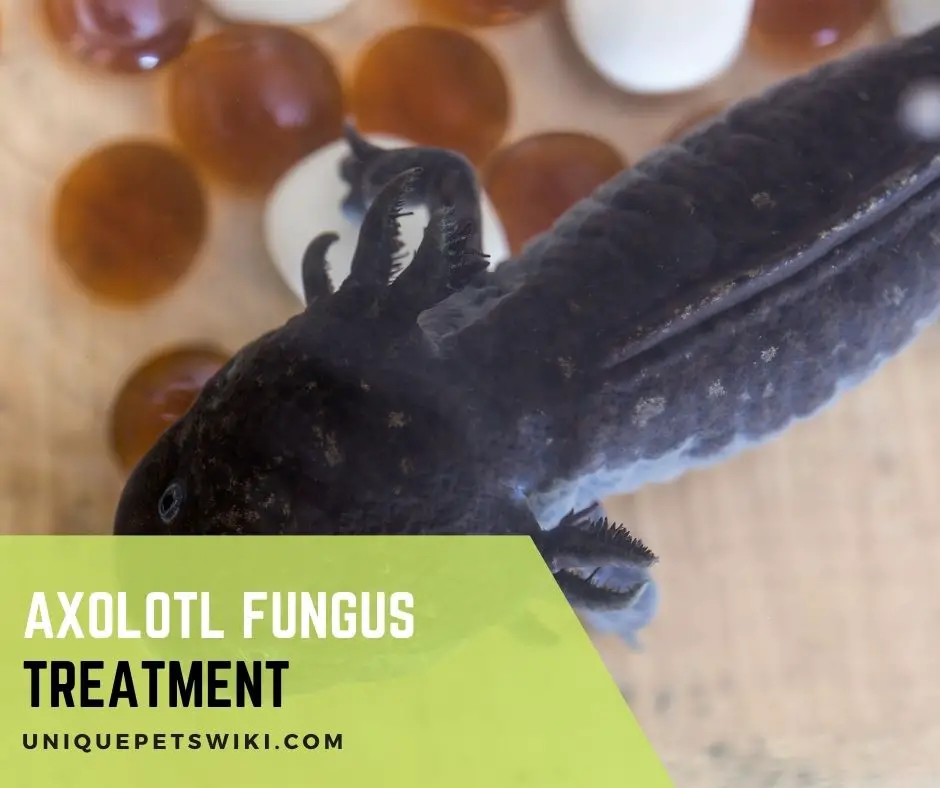If you are reading this guide, your axolotl probably has some feather-like white stuff on its gills and skin.
Typically this is attributed to axolotl fungus – a common skin issue seen in these aquatic pets.
Fortunately, mild cases of axolotl fungus are quite easy to treat and if you’re proactive about it, your pet will be normal within no time.
In this guide, we tell you everything you need to know about axolotl fungus treatment that can help you treat the infection and prevent it.
Let us get straight to it!
Contents
How to Know if Your Axolotl Has Fungus?
Axolotl fungus on gills is a common ailment seen in these pets. It comes on rather suddenly and there are definite signs to help identify it.
Axolotl fungus begins with tufts of feathery or cottony balls on its gills. The fungus may also be present at the site of a wound or injury on parts of its body other than the gills.
In addition, a ball or cloudy area that is slimy may also appear on the skin.
Axolotl gill fungus sometimes results in whitening or cloudy tips of the gill stalks. As the condition worsens, the gills become very thin and look like they are disintegrating.
Also read: Axolotl White Fungus On Gills: Signs, Cause, and Treatment
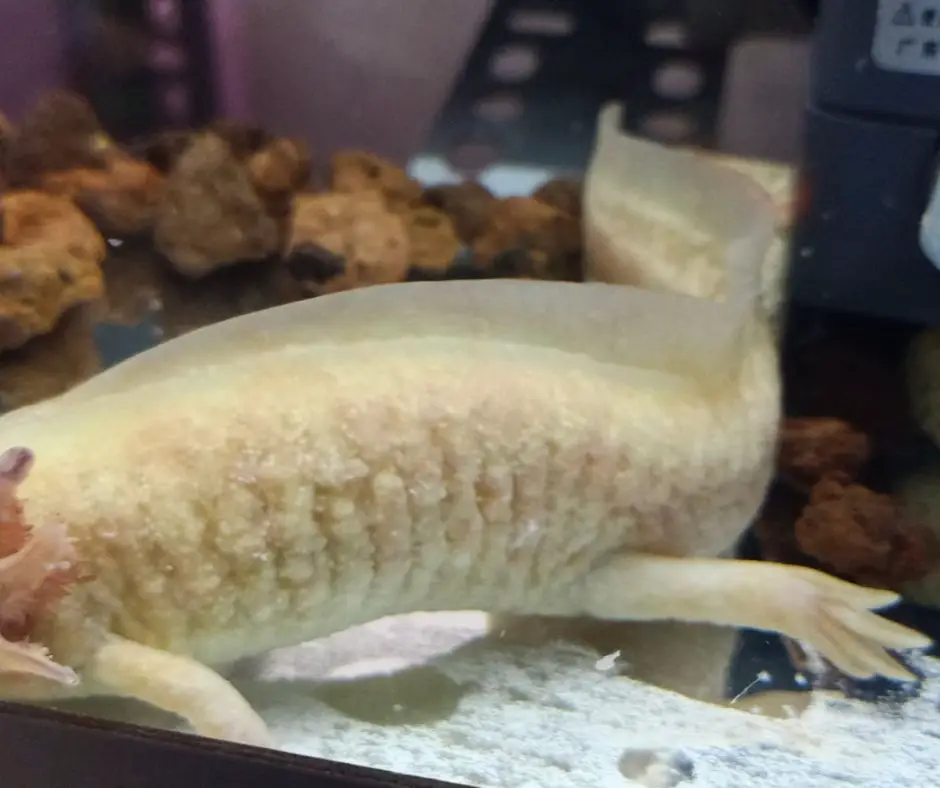
What Causes Axolotl Fungus?
Here are some of the major culprits that could lead to axolotl fungus:
- Poor immunity
- Unbalanced environment
- Lack of strong microbiome
- Stress
- Warm temperature
Poor immunity
The simultaneous weakening of your axolotl’s immune system due to poor water quality or improper water parameters is one of the major causes of axolotl fungus.
Your pet may even have a compromised immune system if sick or injured. Weak immunity makes your pet susceptible to skin issues, including bacterial and fungal problems.
Also read: Full Requirements & Water Conditions for Axolotl in Captivity
Unbalanced environment
An unbalanced environment can result from poor water parameters. The most important parameters include the water’s pH, ammonia, nitrites, and nitrates.
An imbalance in these can adversely impact your pet and result in fungal infections.
Also read: pH for Axolotl and Tips to Maintain
Lack of strong microbiome
Microbiome means a community of fungi, bacteria, and other microbes that live in the tank with your axolotl.
Even if your water parameters are perfect and the water temperature is perfect, your axolotl could still get sick if there are more harmful bacteria or fungi in its environment.
That is why it is important to sterilize the tank. We will discuss this in detail, in the sections below.
Also read: How To Cycle Tank For Axolotl: 7 Steps for Beginners
Stress
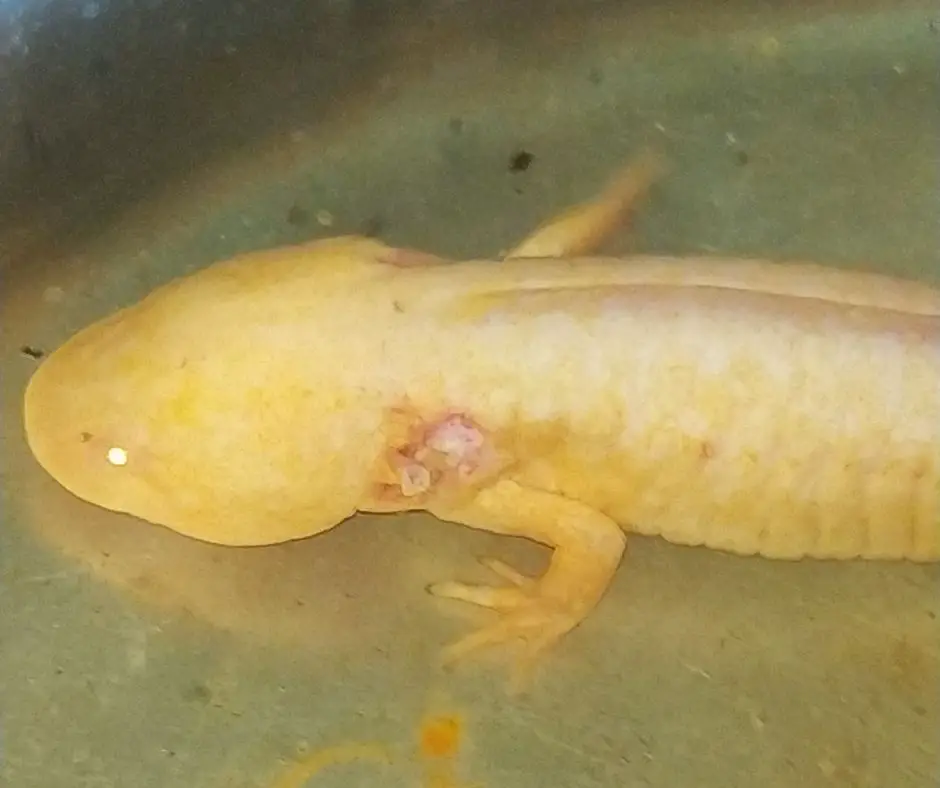
Several factors can cause stress in axolotls. As mentioned earlier, poor water parameters are a significant cause of stress in axolotls.
Your axolotl could even get stressed due to strong bright light. These nocturnal creatures need the dark so make sure you haven’t placed the tank near a bright light source.
Also read: 10 Axolotl Stress Signs
Warm temperature
Axies prefer cool water and warm water can stress them out immensely. Warm water even becomes a breeding ground for fungi and bacteria.
Try and maintain the tank water temperature between 60-64 F for your pets to thrive.
Also read: Axolotl Temperature (Tips to Maintain an Ideal Temperature)
How Do You Get Rid of Fungus on Axolotl Gills?
There are many ways to easily treat axolotl fungus at home.
For mild cases, you can use tea bags or tea tree oil. Simply transfer your axolotl to a container with cold water (hospital tank or quarantine tank) and add a tea bag to it.
You can also use Indian almond leaves. You will need to use antifungal medicines, antibiotics to treat secondary infections, and/or special water conditioners and baths, For severe infections.
Let us take a look at each of these in detail.
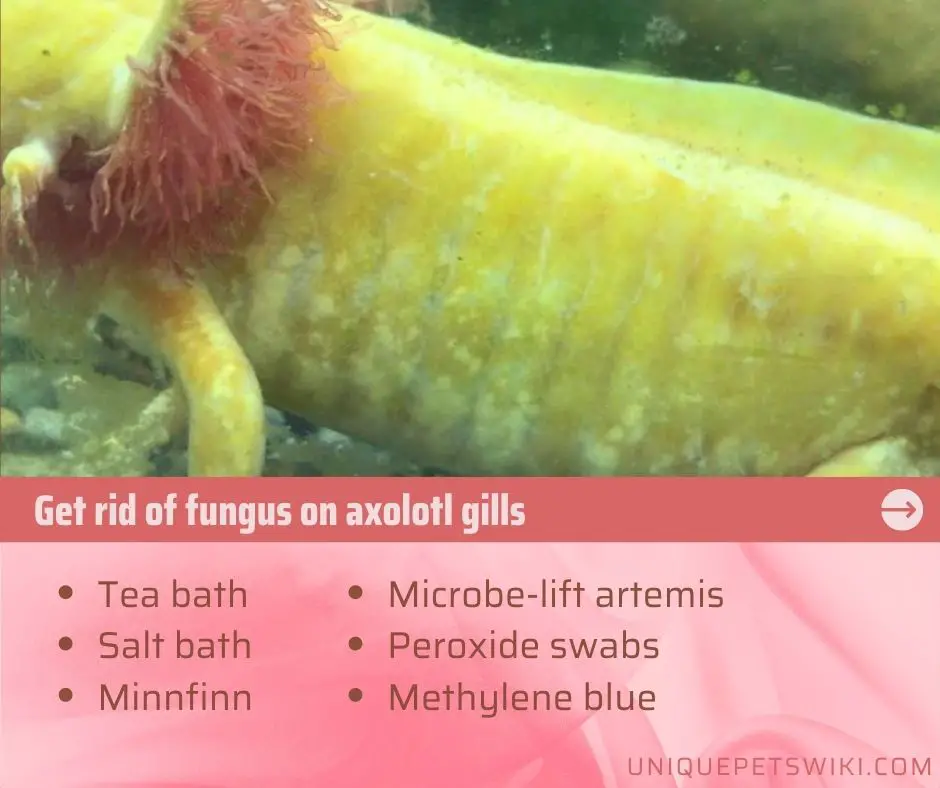
Tea Bath
You can use rooibos, black, or green tea to treat axolotl fungus. The tannins in the tea help make its skin slightly acidic which eliminates the fungal infection.
Look for organic tea that contains 100% tea without any additives or preservatives.
Dosage
You want to brew one entire mug of tea for a container of 3 gallons or about 10 liters of water. Cool the tea after brewing it. If needed, refrigerate it. Remember: axolotls do not like warm water.
You can mix the cooled tea with refrigerated, dechlorinated water. The mixture should be at 60-64 F. Place the axolotl in this mixture for around 10-15 minutes.
Alternatively, add a tea bag (make sure it only contains pure tea and nothing else) directly into your axolotl’s tank.
The color of your tank water should change to a medium yellow-red color. Leave your axolotl in the tank until its next water change.
Effective Treatment
Yes, tea baths are an effective way to treat mild cases of axolotl gill fungus.
Pros and Cons
While tea baths are effective for mild cases of Axolotl fungus, there are a few downsides to it. According to a news article in CBC, the pesticide traces in tea are sometimes higher than permissible amounts.
Moreover, some axolotls have suffered from flaking and peeling skin after prolonged exposure to tea baths.
That is why it is important to use pure tea and only place your pet in the bath for a short period.
Check out our detailed guide on Axolotl Tea Bath
Salt Bath
Salt is an effective treatment for axolotl fungus. You need to use aquarium salt and not table salt or rock salt.
Dosage
The recommended dosage is 1 tbsp per gallon of water. You can quarantine your axolotl and add the aquarium salt to its hospital tank. Keep your pet in the salt bath for 10 minutes each, twice a day.
You can also add aquarium salt to the main tank when performing water changes to prevent fungal and bacterial skin diseases in your axolotl.
Effective
When used properly, it can stimulate your axolotl’s skin to produce mucus that attacks fungal pathogens.
Pros and Cons
When used as directed, a salt bath is 100% safe and effective in treating axolotl fungus. However, prolonged exposure to salt baths could cause skin peeling, bleeding, and damaged gills in axolotls.
Check out our detailed guide on Axolotl Salt Bath
MinnFinn
MinnFin is a natural biodegradable treatment that heals axolotls from a broad spectrum of bacterial or fungal issues.
It is recommended when your entire aquarium shows signs of the disease. So, if you have two or more axolotls, then administer MinnFinn as directed to the entire tank.
Dosage
Add one treatment to a 20-gallon tank. The medicine will disintegrate and most axolotls only need one or two treatments.
Effective
MinnFinn is very effective and has helped cure various skin issues in many axolotls.
Pros and Cons
While the treatment is safe and non-toxic, it does disturb the tank’s good bacteria. The manufacturers also state this on their products. It might take a couple of weeks to get your tank back to normal.
MinnFinn and NeuFinn Biodegradable Pond Treatment
- Natural Biodegradable Treatment
- Treat A Broad Spectrum of issues
- Easy To Dose In Ponds
Last update on 2022-12-29 / Affiliate links / Images from Amazon Product Advertising API
Microbe-Lift Artemis
Microbe-Lift Artemis is a water conditioner that detoxifies your tank by removing heavy metals and toxins from it.
It also corrects the water parameters by reducing ammonia, nitrites, and chlorine in the water.
To improve the health of your axolotl it rejuvenates electrolytes, acts as a skin slime replenisher, and boosts alkalinity.
Dosage
Add 1 tsp (or 5ml) per 10 gallons of water. You can even use it as a preventive treatment for fungal infections during every water change and when setting up a new tank.
Effective
Yes, this is an effective treatment to eliminate axolotl skin fungus and prevent it.
Pros and Cons
When used as directed, this is a safe product. However, a couple of users reported that it reduced oxygen levels in an already established tank which could harm your fish and axolotls.
If you find your pet getting stressed, perform a partial water change and put an aerator to increase the oxygen levels in the tank.
MICROBE-LIFT XTA16 Xtreme Water Conditioner Treatment
- FULL-FUNCTION WATER CONDITIONER: Formulated to condition and instantly "age" new water to prepare for marine life; Safe to use when setting up a new pond or aquarium, making water changes, or when adding new fish, invertebrates, amphibians, or plants
- CLEANER WATER: Xtreme solution detoxifies nitrite, removes ammonia and chlorine, and destroys and removes chloramines; these properties create a cleaner environment for marine life, plants, and coral in your aquarium and fish tank
- IMPROVES WATER STABILITY: By adding a multi-part skin-slime replacer, essential electrolytes, and boosting alkalinity, Xtreme creates an environment that boosts the health of your fish
- PREVENTS OSMOTIC SHOCK: XTreme detoxifies heavy metals such as copper and lead by both chelation and precipitation; this process prevents exposure to osmotic shock that is often caused when new water is added
- RECOMMENDATIONS: Perform regular water changes to keep the alkalinity and pH stable; Use XTreme at the standard dosage rate to eliminate and control each measured 1 mg/L, or fraction thereof, of total ammonia
Last update on 2022-12-30 / Affiliate links / Images from Amazon Product Advertising API
Peroxide Swabs
Applying a swab of H2O2 or hydrogen peroxide can also benefit your axolotl. Peroxide eliminates bacteria and fungi and the oxygen helps your Axie regenerate its gills and skin.
Dosage
Briefly take your axolotl out of the tank and place it in a shallow container of dechlorinated cool water.
Apply a cotton ball soaked in hydrogen peroxide directly to the gills and other areas with the white stuff.
You can also clean the entire tank with hydrogen peroxide to eliminate fungus from all surfaces.
Effective
Yes, this is an effective treatment for moderate to severe fungal infection in Axolotls.
Amazon Basics Hydrogen Peroxide Topical Solution USP
- One 32-fluid ounce bottle of first aid antiseptic
- First aid to help prevent risk of infection from minor cuts, scrapes and burns
- Active ingredient: 3% hydrogen peroxide (stabilized)
- Not made with natural rubber latex
- Paraben and Phthalate Free
Last update on 2022-12-29 / Affiliate links / Images from Amazon Product Advertising API
Methylene blue
Methylene blue is a highly effective treatment for fungal infections in freshwater and saltwater fish, salamanders, newts, etc. It also works on Axolotl fungus.
Dosage
Different products will give you different instructions about how much to use.
In general, add 1 tsp of 2.303% Methylene Blue to 20-gallons of water. It is best to not treat the entire tank but to separate your axolotl in a ‘hospital tank’ and treat that.
Let your pet remain in the methylene blue bath for 15-20 minutes before returning it to its main tank. Continue treatment for three days. Change 1/3rd of your pet’s tank water per week.
You can also mix a teaspoon of methylene blue with ½ tsp of Epsom salts and add it to the hospital tank.
Effective
Methylene blue sticks to the axolotl’s skin and provides oxygen which facilitates healing.
Pros and Cons
The treatment is very effective for mild to moderate fungal infections in Axolotls.
However, it stains everything blue, so be careful while handling it. It is also lethal to live plants, so do not add it to the main axolotl tank.
Methylene Blue-General Disease Prevention Treatment for Aquarium
- Kordon methylene blue 4oz
- Methylene blue is effective against superficial fungal infections of fishes
- The drug may be used as an alternative to malachite green for the control of fungus
Last update on 2022-12-29 / Affiliate links / Images from Amazon Product Advertising API
A Word of Caution
Never try to pull out the fungus on your axolotl’s skin or gills. It can hurt your pet and even damage its gills. It is also very stressful for your axolotl.
How Long Does the Axolotl Fungus Treatment Take?
Fortunately, most cases of axolotl fungus only attack the external tissues. By using one of the above remedies, you can treat the fungus in a couple of days.
While treating your pet, it is important to quarantine it, especially if you have other inhabitants in the aquarium. Create a hospital tank and perform the treatments there.
We recommend trying out the other options above If one treatment does not work. Once you have successfully treated your Axie, you can go back to taking care of it as usual.
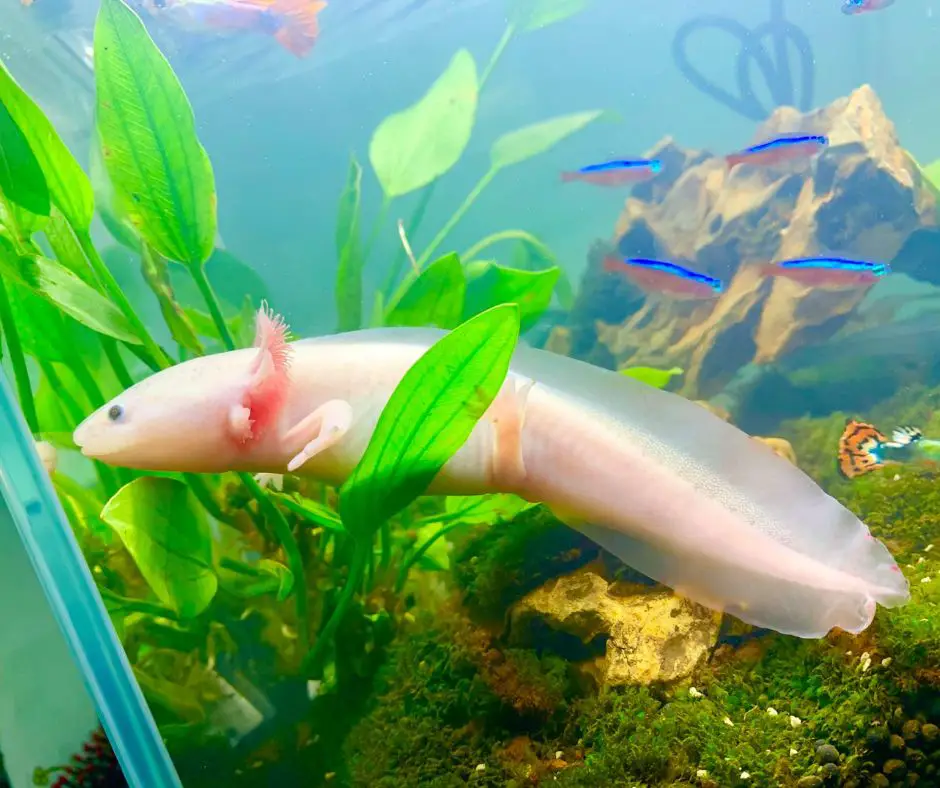
What Happens If Axolotl Fungus is Left Untreated?
When caught in its early stages, axolotl fungus is easy to cure. It is important to treat the infection as soon as you sight it.
If left untreated, it can worsen, spread, stress your pet, and eventually kill your axolotl.
How to Prevent Axolotl Fungus
There are a couple of things you can do to prevent fungal infections in axolotls:
- Avoiding injuries or poor water quality
Injuries and wounds are very susceptible to fungal and bacterial skin infections. So make sure you avoid them and keep your pet safe. You can prevent injuries by removing sharp accessories from the tank.
Do not forget to use water testing kits from time to time to ensure optimum water parameters like pH, temperature, etc.
Also read: 6 Best Axolotl Accessories
- UV Sterilization
UV sterilization kills bacteria, viruses, algae, and other harmful pathogens from your pet’s tank. Keep the UV sterilizing lamp away from your pet’s active area as its rays should not fall directly on your pet.
- Performing regular water changes
Perform at least 80% water changes every couple of days, especially if you do not have a water pump, air stone, or filter.
Also read: 7 Best Water Filter For Axolotl
Wrapping Up
If your pet axolotl has developed white cotton-like balls on its skin and gills, it is likely a fungal infection.
The first thing to do is to quarantine your pet in a hospital tank. Next, add some brewed cold (pure) tea to it. You can also use other remedies like methylene blue or Indian almond leaves.
We hope this guide helps you take prompt corrective steps, so your axolotl feels better quickly.
